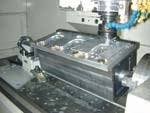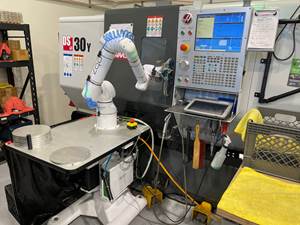Overcoming Overflow
Making the best use of limited resources helped this shop bounce back from a flood. Now the shop's most important process-improvement tool is the software it bought to manage the flow of information.
Change is difficult even when the need for it is clear. We fear unanticipated costs. But there can also be unanticipated benefits. The organization that misses out on these can't know how far it might have gone if only it had made that leap.
Unitech is a Kansas City, Missouri, job shop with six CNC machines and just under 20 employees. The small shop began using a shop management software package because employees in the office were working more hours and more days per week than employees in the rest of the company. Processing orders manually worked fine when the shop was tiny, but success and growth made the paperwork multiply. The office became the bottleneck. Machines waited when material couldn't be ordered fast enough or when the operator waited for work instructions. Using software to automate ordering, billing, inventory tracking and the creation of the travelers let Unitech do away with this source of delay. It also let shop management end the practice of working Sundays to catch up. These were the benefits the shop was banking on.
But company president Craig Schroer soon found still other ways to apply the software. Its analysis of the setup and machining time data logged by operators let him see the profitability of each job at a glance. The same analysis also let him calculate an ideal inventory quantity for each part number—the point at which more units would waste money and fewer units would jeopardize just-in-time delivery. These are the benefits that went beyond what the shop had expected.
As for being willing to change, Mr. Schroer has an advantage.
He learned a great deal about change in 1990. That was the year flood waters destroyed most of the equipment in his shop.
The Deluge
The Blue River overflowing its banks left the shop 6 feet under water. Two of the three CNC machines in the shop at that time had control units sitting on the floor—these machines were lost. (A third machine with pendant control and corrosion-resistant contacts is still running today.) Another disaster came in the wake of this one: The shop lost the customer accounting for the lion's share of its business. These two setbacks left Mr. Schroer with a sense of urgency. He felt he would have to move aggressively to make up lost time.
At first, buying equipment wasn't the answer because he had no assurance of enough work to occupy the new machines. But new strategies for moving work across the existing machines offered a way for him to open extra capacity for little expense. The shop has repeatedly relocated machines and work stations in search of the optimum mix, and as equipment and operations continue to evolve, the shop remains diligent about continually stirring this pot.
Improved information flow was the next step. The company had long used a variety of software tools, chief among them an accounting package used for quoting. However, purchase orders and travelers were written by hand, and the inefficiency of this approach became steadily more apparent as the shop took on more jobs. A fundamental change to the shop's information management process was needed.
Unitech began using shop management software from JobBOSS/Exact (Minneapolis, Minnesota) in 1998. "We didn't phase in, we jumped in," Mr. Schroer says. He thinks his transition may have set a record for starting up with this software. He and one employee, buyer/expediter Michele Burnworth, spent long days at two laptop computers entering data relevant to the shop's machines, operations, suppliers and—most time consuming of all—the various combinations of stock size, stock dimensions and material type that the shop might use (about 400 permutations in all). Equipping the system took one week, but within that time, the two of them completely transitioned two companies to running with JobBOSS/Exact. They entered data not just for the machine shop, but also for a sister company that performs painting of machined parts. (Located next to the machine shop, the painting company was previously underwater, too.)
The software took over quoting, the one management function that had been automated all along. It also automated the creation of material orders and the traveler documents that follow each job. Response time improved dramatically because new jobs coming into the company could be set in motion at once, instead of lingering while management personnel made basic, repetitive decisions about each job.
The software also automated information tasks that often had not been performed at all. Unitech's operators had always logged setup times, cycle times and other data for work in process, but the software's effortless analysis of the data now gave Unitech more information on the back end of its process than it ever had before. And as the shop began to parlay its improved response time into reduced inventory, this analysis became particularly valuable. The shop could deduce just how little inventory it could get away with and still provide just-in-time (JIT) service.
Inventory Averted
There's a distinction to be made between JIT delivery and JIT production. One is an achievable goal, while the other may be impossible for the true job shop to realize. Different jobs have different response times, and a contract shop needs to maintain an inventory buffer in order to meet a customer's immediate need while setting up to run more of that part.
But the buffer has a cost. That inventory represents tied-up capital, and its value can be lost if the customer changes its mind about needing that part. Because of the financial burden and risk, a buffer too large can cause the profitability of a job to be lost.
Comparing the actual cost of materials, labor and machine hours against the receivable value of any batch, the shop management software lets Mr. Schroer see at a glance if that run of parts was profitable. "When I see the percent profit drop below a certain value, I start asking questions."
The cold analysis is valuable. For the shop making guesses about its costs, an almost irresistible pressure is to undercut financial health in pursuit of a job that seems like it ought to be profitable. Mr. Schroer now knows better than ever before which jobs he should walk away from.
But the software also lets him analyze time, and this analysis leads to savings of its own. By combining response time information with customers' estimated projections of their needs for various parts, the shop can arrive at an estimate of how much (or how little) inventory to keep in stock in order to deliver on demand. This inventory level then feeds back into the profitability calculations. Mr. Schroer estimates the cost of inventory at a 10 percent return on the cost of machining those parts. This is the return he would otherwise get on that money if it wasn't tied up in finished parts waiting to be bought.
In some cases, it might be possible to offset this cost of inventory through the efficiencies of running more pieces at once. However, this is dangerous thinking, because that approach makes no allowance for the uncertainty whether the customer will eventually order the extra pieces. Keeping even a small inventory buffer without excessive risk requires a close relationship with the customer.
One customer with whom Unitech does have this close relationship recently asked the shop to take a step toward even greater responsiveness. Last year, this customer told its top 50 suppliers they would all have to be ready for e-commerce within one year.
The problem was, this company couldn't tell its suppliers just what "e-commerce" meant. They were left to figure it out on their own. And without knowing it, Unitech—despite being number 50 in billings on the top-50 list—went farther in response to this requirement than any of the other 49.
Enter The Internet
The customer is an OEM of electric utility trucks. Among the components it asks Unitech to supply are the machined and welded lift baskets that power company maintenance workers stand in to fix electric lines. Making these baskets is the kind of job Unitech considers ideal. The machine shop and its sister company together perform machining, welding and painting, so Unitech is at its most competitive on jobs that combine these disciplines.
"Most companies think e-commerce means receiving an order by e-mail they would otherwise get by fax," Mr. Schroer says. For the lift basket customer, Unitech was already doing this much. The shop receives daily e-mail from the company listing part numbers and quantities required. Mr. Schroer assumed this would not be enough to meet the customer's new requirement. Looking to the shop's own information management system, he began to ask a question. Why can't data being tracked and generated by JobBoss—including open jobs, completed jobs, inventory quantities, receivables and payment history—be made available directly to the customer across the Web?
It could. JobBoss's parent company Kewill was just then developing a product to let shops provide their customers with Internet access to this type of information. Unitech became a beta user of this software. In a presentation to the lift basket customer, Mr. Schroer demonstrated how, thanks to the new software, representatives of that company could now log into Unitech's Web site to check order status and quantities in stock for all part numbers the company has Unitech produce.
It was a success, he says. It was a success in the most significant way it needed to be a success—it showed the shop's commitment to responding to the customer's stated priorities. And it continues to reinforce the relationship. Key personnel at that company see the Unitech name on their screens as they keep the site open among the other applications on their desktop PCs.
But from a practical standpoint, this access was more than the customer needed. No other supplier gave the company comparable access. As a result, the company has no procedures or even habits in place for using the Web in this way.
For now, receiving orders via e-mail is e-commerce enough.
The Next Level
The next level of e-commerce will come when work information can flow two ways, Mr. Schroer says. That is, when the customer can not only receive information as it can from Unitech today, but also input its needs directly to the shop so the shop's production schedule can update automatically. In that system, the critical link would no longer be a human being (specifically, Ms. Burnworth) routinely checking her e-mail.
Mr. Schroer is confident that this level of shop control automation is coming. Another advantage he sees to the Internet access he has put in place is that his shop is now that much closer to implementing such technology when it arrives.
It's one thing for a tiny shop to grow bigger, he says. There is nowhere to go but up. A more difficult point comes when the shop has grown too big to be small, but not yet big enough to produce effectively in the ways a big shop can.
Unitech's response is to work aggressively to try to grow the shop through this period. Where the shop does not yet have the physical capacity to rival large competitors, that will come in time. Until then, Mr. Schroer plans to use advantages like better information flow—with the efficiency and customer service this lets him achieve—to make sure the work keeps flowing through his shop.
Related Content
How this Job Shop Grew Capacity Without Expanding Footprint
This shop relies on digital solutions to grow their manufacturing business. With this approach, W.A. Pfeiffer has achieved seamless end-to-end connectivity, shorter lead times and increased throughput.
Read MoreBecoming a More Efficient Shop With the Right Processes and Software
After refining its machining processes for more efficient production, this shop still needed a better way to track its data. Here's how it found a software solution.
Read MoreShop Moves to Aerospace Machining With Help From ERP
Coastal Machine is an oil and gas shop that pivoted to aerospace manufacturing with the help of an ERP system that made the certification process simple.
Read MoreHow to Grow the Business with Real-Time Job Status Data
ERP systems that focus on making data more accessible can improve communication within a shop, reducing wasteful errors and improving capacity.
Read MoreRead Next
The Cut Scene: The Finer Details of Large-Format Machining
Small details and features can have an outsized impact on large parts, such as Barbco’s collapsible utility drill head.
Read More3 Mistakes That Cause CNC Programs to Fail
Despite enhancements to manufacturing technology, there are still issues today that can cause programs to fail. These failures can cause lost time, scrapped parts, damaged machines and even injured operators.
Read More
.jpg;width=70;height=70;mode=crop)














.png;maxWidth=300;quality=90)




.png;maxWidth=300;quality=90)
















